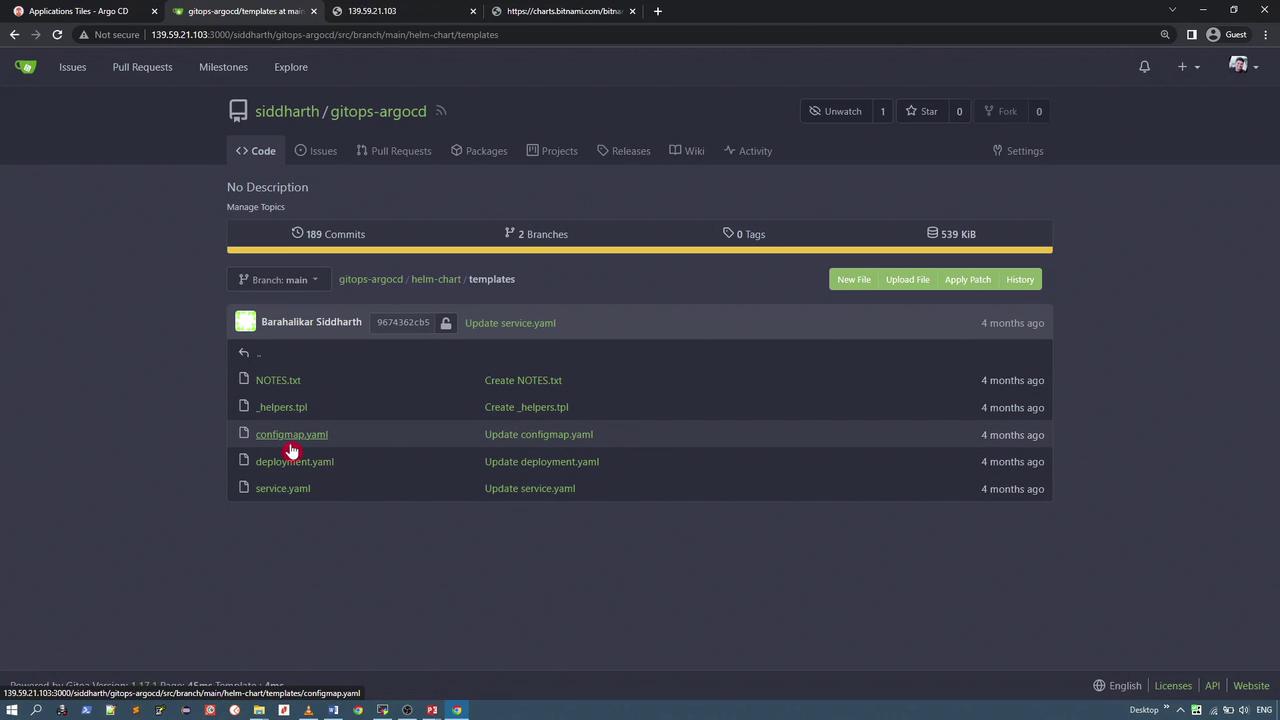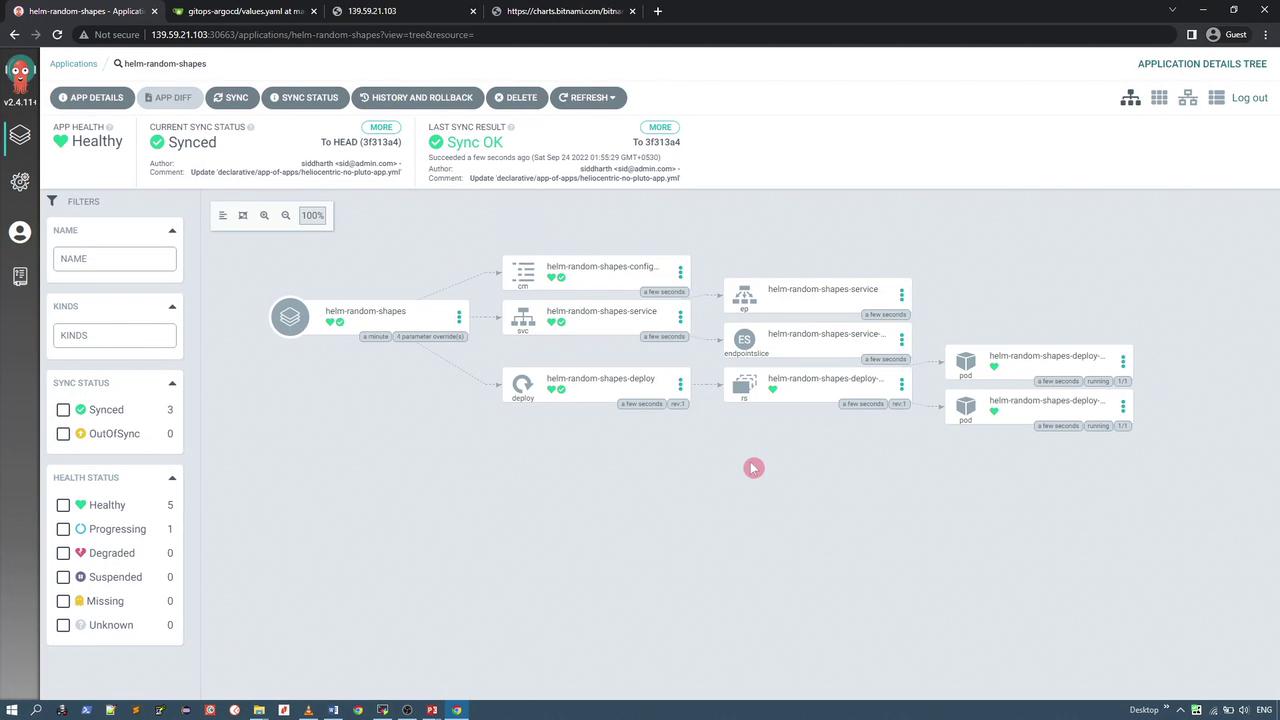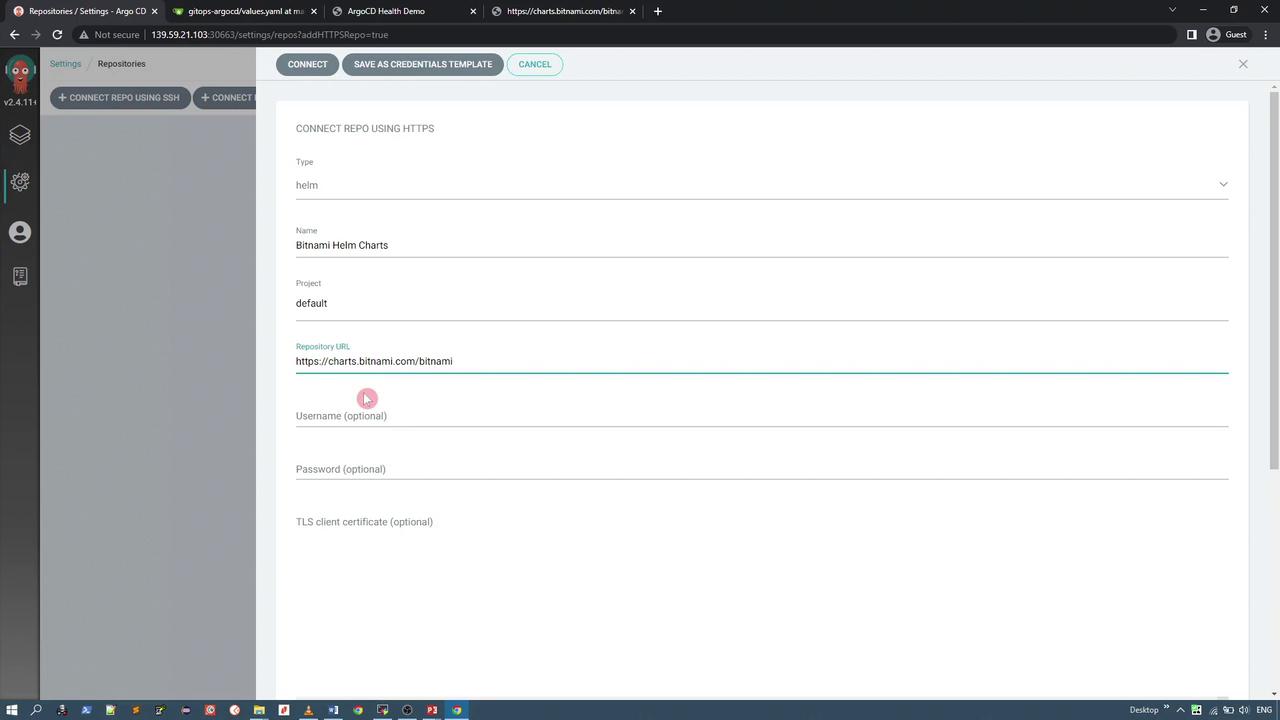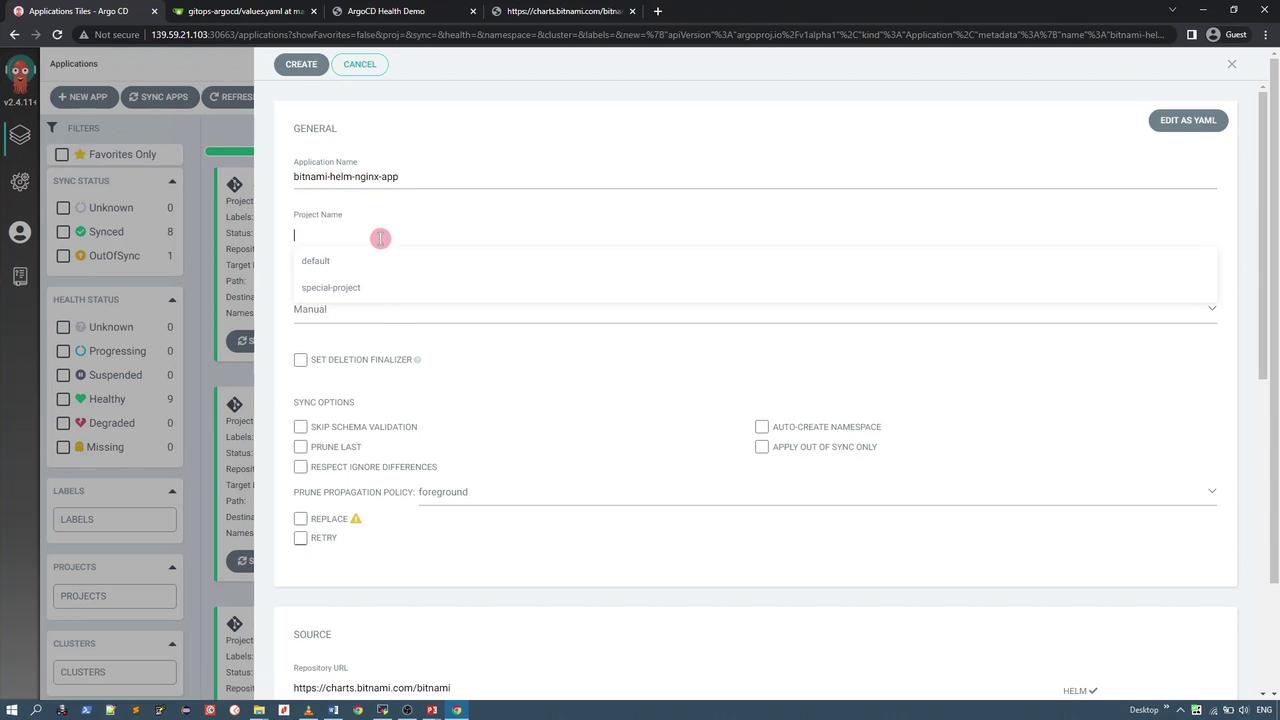GitOps with ArgoCD
Deploy apps using HELM Chart 2
This article explains how to deploy a Helm chart using ArgoCD and demonstrates how to manage Helm charts from multiple sources. The GitOps ArgoCD repository includes a Helm chart that defines three Kubernetes resources: a ConfigMap, a Deployment, and a Service. The chart dynamically replaces template values using the configurations specified in the values.yaml file.

Helm Chart Templates
Deployment Template
The Deployment template leverages values from the values.yaml file for settings such as the replica count and container image details. Below is an excerpt from the Deployment template:
apiVersion: apps/v1
kind: Deployment
metadata:
name: {{ .Release.Name }}-deploy
labels:
{{- include "random-shapes.labels" . | indent 4 }}
spec:
replicas: {{ .Values.replicaCount }}
selector:
matchLabels:
{{- include "random-shapes.selectorLabels" . | indent 6 }}
template:
metadata:
{{- with .Values.podAnnotations }}
annotations:
{{- toYaml . | indent 8 }}
{{- end }}
labels:
{{- include "random-shapes.selectorLabels" . | indent 8 }}
spec:
containers:
- name: {{ .Chart.Name }}
image: {{ .Values.image.repository }}
imagePullPolicy: {{ .Values.image.pullPolicy }}
ConfigMap Template
The ConfigMap template assigns color values for each shape as defined in the values.yaml file. This configuration overrides the default shape colors, as shown below:
apiVersion: v1
kind: ConfigMap
metadata:
name: {{ .Release.Name }}-configmap
data:
CIRCLE_COLOR: {{ .Values.color.circle }}
OVAL_COLOR: {{ .Values.color.oval }}
SQUARE_COLOR: {{ .Values.color.square }}
TRIANGLE_COLOR: {{ .Values.color.triangle }}
RECTANGLE_COLOR: {{ .Values.color.rectangle }}
Default values.yaml
The default values.yaml file provides hardcoded configurations such as the replica count, image credentials, and default colors for shapes. Notably, all shapes are initially set to black and the service is configured as type ClusterIP:
replicaCount: 1
image:
repository: siddharth67/php-random-shapes:v1
pullPolicy: IfNotPresent
# Overrides the image tag whose default is the chart appVersion.
tag: ""
imagePullSecrets: []
nameOverride: ""
fullnameOverride: ""
service:
type: ClusterIP
port: 80
targetPort: 80
color:
circle: black
oval: black
triangle: black
rectangle: black
square: black
Deploying the Application with ArgoCD CLI
You can create an application in ArgoCD using either the CLI or the UI. In this example, the CLI is used to create an application named "helm-random-shapes". The command specifies the repository URL, path, and overrides some default values via the --helm-set parameter. For instance, the command sets the replica count to 2, updates the colors for the circle and square to pink and green respectively, and changes the service type to NodePort.
argocd app create helm-random-shapes \
--repo http://139.59.21.103:3000/siddharth/gitops-argocd \
--path helm-chart \
--helm-set replicaCount=2 \
--helm-set color.circle=pink \
--helm-set color.square=green \
--helm-set service.type=NodePort \
--dest-namespace default \
--dest-server https://kubernetes.default.svc
After creating the application, the CLI returns a confirmation message:
application 'helm-random-shapes' created
You can verify the deployment by accessing the ArgoCD UI. The new application may initially show an out-of-sync status until you click "Synchronize" to deploy the resources.

Reviewing the Application Manifest
To inspect the application manifest, navigate to the application details in the ArgoCD UI and click on "Manifest". The manifest confirms Helm as the source and includes the parameters set with the --helm-set flags:
project: default
source:
repoURL: 'http://139.59.21.103:3000/siddharth/gitops-argocd'
path: helm-chart
helm:
parameters:
- name: replicaCount
value: '2'
- name: color_circle
value: pink
- name: color_square
value: green
- name: service.type
value: NodePort
destination:
server: 'https://kubernetes.default.svc'
namespace: default
Note
The service is now listening on a specific NodePort (e.g., 32142). Among the five shapes, the circle and square are overridden to pink and green, while the remaining shapes retain the default black color.
Once ArgoCD deploys the Helm chart, it assumes full management of the application. Consequently, running a standard helm ls command will not display the application, since it is exclusively managed by ArgoCD.
Checking Application Metadata via ArgoCD
To view detailed metadata for the deployed Helm chart, such as resources, health status, and source/target details, execute the following command:
argocd app get helm-random-shapes
The output will include details similar to:
Name: helm-random-shapes
Project: default
Server: https://kubernetes.default.svc
Namespace: default
URL: http://10.98.110.228:443/applications/helm-random-shapes
Repo: http://139.59.21.103:3000/siddharth/gitops-argocd
Path: helm-chart
Sync Window: Sync Allowed
Sync Policy: <none>
Sync Status: Synced to (3f313a4)
Health Status: Healthy
And a detailed resource list:
GROUP KIND NAMESPACE NAME STATUS HEALTH HOOK MESSAGE
apps ConfigMap default helm-random-shapes-configmap Synced Healthy configmap/helm-random-shapes-configmap created
Service default helm-random-shapes-service Synced Healthy service/helm-random-shapes-service created
Deployment default helm-random-shapes-deploy Synced Healthy deployment.apps/helm-random-shapes-deploy created
Managing Helm Charts from Helm Repositories
ArgoCD can also manage Helm charts hosted in external repositories such as Bitnami. For example, you might deploy an application using the Bitnami Nginx chart.
Example Bitnami Helm Chart Specification
Below is an excerpt of a Helm chart specification from Bitnami that demonstrates how charts include metadata, dependencies, and other parameters:
apiVersion: v1
entries:
airflow:
- annotations:
category: WorkFlow
apiVersion: v2
appVersion: 2.3.4
created: "2022-09-21T10:26:03.089700388Z"
dependencies:
- condition: redis.enabled
name: redis
repository: https://charts.bitnami.com/bitnami
version: 17.x.x
- condition: postgresql.enabled
name: postgresql
repository: https://charts.bitnami.com/bitnami
version: 11.x.x
- name: common
repository: https://charts.bitnami.com/bitnami
tags:
- bitnami-common
version: 2.x.x
description: Apache Airflow is a tool to express and execute workflows as directed
acyclic graphs (DAGs). It includes utilities to schedule tasks, monitor task
progress and handle task dependencies.
digest: f128dfb6320c79d19cca88384412389f7a0a7cdf9ec459de9bdc2f8fa086d
home: https://github.com/bitnami/charts/tree/master/bitnami/airflow
icon: https://bitnami.com/assets/stacks/airflow/img/airflow-stack-220x234.png
keywords:
- apache
- airflow
- workflow
- dag
maintainers:
- name: Bitnami
Another example, for the Discourse chart, is shown below:
tags:
- bitnami-common
version: 1.x.x
description: Discourse is an open source discussion platform with built-in moderation
and governance systems that let discussion communities protect themselves from
bad actors even without official moderators.
digest: sha256:d52bdba510f98909bf3fee38b9eecc106d6ded76737351422d1161880f4837
home: https://github.com/bitnami/charts/tree/master/bitnami/discourse
icon: https://bitnami.com/assets/stacks/discourse/img/discourse-stack-220x234.png
keywords:
- community
- forum
maintainers:
- email: [email protected]
name: Bitnami
- email: [email protected]
name: paulzcan
- email: [email protected]
name: lucaprete
name: discourse
sources:
- https://github.com/bitnami/bitnami-docker-discourse
- https://github.com/spinnaker
- https://www.discourse.org/
urls: https://charts.bitnami.com/bitnami/discourse-7.0.16.tgz
version: 7.0.16
annotations:
category: Forum
apiVersion: v2
appVersion: 2.8.3
created: "2022-04-19T13:33:08.1651570512Z"
dependencies:
condition: redis.enabled
name: redis
repository: https://charts.bitnami.com/bitnami
Configuring the Helm Repository in ArgoCD
Configure the Helm repository in ArgoCD by providing the repository URL (for example, charts.bitnami.com), selecting the repository type (Helm), and including any necessary credentials. The diagram below illustrates the repository connection interface:

Deploying an Application from the Bitnami Helm Repository
For this demonstration, we deploy the Bitnami Nginx chart. Using the ArgoCD UI, create an application by selecting the Bitnami Helm repository and choosing the desired chart (e.g., Nginx). You can specify the chart version (such as 12.0.3) and set the destination namespace (e.g., Bitnami). Override any necessary parameters; for example, change the service type from LoadBalancer to NodePort if not using a cloud-based service.

After setting your parameters, the application manifest displays a configuration similar to the following:
apiVersion: argoproj.io/v1alpha1
kind: Application
metadata:
name: bitnami-helm-nginx-app
spec:
destination:
name: bitnami
server: 'https://kubernetes.default.svc'
source:
path: chart
repoURL: 'https://charts.bitnami.com/bitnami'
targetRevision: 12.0.3
helm:
parameters:
- name: service.type
value: NodePort
project: default
syncPolicy:
automated: null
syncOptions:
- CreateNamespace=true
Synchronize the application to deploy the resources. In this example, the deployment includes a Deployment and a Service. The Service is assigned a NodePort (for instance, 31640). Below is an excerpt of the deployed Service configuration:
apiVersion: v1
kind: Service
metadata:
annotations:
kubectl.kubernetes.io/last-applied-configuration: >
{"apiVersion":"v1","kind":"Service","metadata":{"annotations":{},"labels":{"app.kubernetes.io/instance":"bitnami-helm-nginx-app","app.kubernetes.io/managed-by":"Helm","app.sh/chart":"nginx-12.0.3"},"name":"bitnami-helm-nginx-app"},"namespace":"bitnami","resourceVersion":"111583"}
name: bitnami-helm-nginx-app
namespace: bitnami
resourceVersion: "111583"
spec:
clusterIP: 10.181.99.14
clusterIPs:
- 10.181.99.14
externalTrafficPolicy: Cluster
internalTrafficPolicy: Cluster
ipFamilies:
- IPv4
ipFamilyPolicy: SingleStack
ports:
- name: http
nodePort: 31640
port: 80
protocol: TCP
targetPort: http
selector:
app.kubernetes.io/instance: bitnami-helm-nginx-app
app.kubernetes.io/name: nginx
sessionAffinity: None
type: NodePort
Once the deployment is healthy and the pod is running, you can access the NGINX homepage via the assigned NodePort, confirming a successful deployment.
Verifying Application Management
Even though Helm CLI commands (e.g., helm ls) may not display these applications because ArgoCD manages them exclusively, you can still retrieve comprehensive details using the ArgoCD CLI:
argocd app get helm-random-shapes
argocd app get bitnami-helm-nginx-app
The output provides metadata such as resource names, health statuses, and sync states. An example output for the helm-random-shapes application is as follows:
Name: helm-random-shapes
Project: default
Server: https://kubernetes.default.svc
Namespace: default
URL: http://10.98.110.228:443/applications/helm-random-shapes
Repo: http://139.59.21.103:3000/siddharth/gitops-argocd
Path: helm-chart
Sync Window: Sync Allowed
Sync Policy: <none>
Sync Status: Synced to (3f313a4)
Health Status: Healthy
GROUP KIND NAMESPACE NAME STATUS HEALTH HOOK MESSAGE
apps ConfigMap default helm-random-shapes-configmap Synced Healthy configmap/helm-random-shapes-configmap created
Service default helm-random-shapes-service Synced Healthy service/helm-random-shapes-service created
Deployment default helm-random-shapes-deploy Synced Healthy deployment.apps/helm-random-shapes-deploy created
Similarly, the Bitnami Nginx application details can be viewed with:
argocd app get bitnami-helm-nginx-app
Conclusion
In this article, we have demonstrated how to deploy and manage Helm charts using ArgoCD. We covered two key scenarios: deploying a Helm chart stored in a Git repository and managing a chart sourced from an external repository like Bitnami. With ArgoCD managing these deployments, you can ensure that your applications remain in-sync and healthy—even if standard Helm CLI commands do not list them.
Thank you for reading.
Watch Video
Watch video content